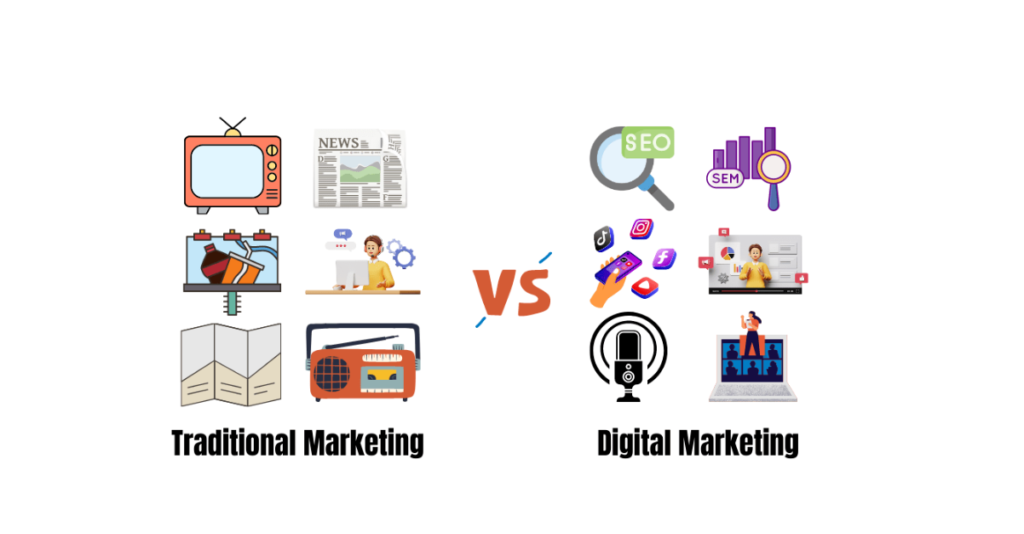Marketing is the heart of every business. Whether it’s a small shop or a big brand, marketing helps in reaching customers and growing sales. But today, businesses have two major options: Traditional Marketing and Digital Marketing. The question is which one is better for you? Let’s break it down in a simple way.
What is Traditional Marketing?
Traditional marketing refers to the old-school ways of advertising that have been around for decades. This includes:
- Newspaper Ads – Advertisements in newspapers and magazines.
- TV & Radio Ads – Commercials that play on television and radio.
- Billboards & Hoardings – Large posters placed in busy areas.
- Pamphlets & Flyers – Printed materials distributed to people.
- Word of Mouth – Recommendations from family and friends.
Features of Traditional Marketing:
- Physical Presence – Uses offline methods like newspapers, TV, and billboards.
- Mass Audience – Targets a broad audience without personalization.
- High Cost – Can be expensive, especially for TV and print ads.
- Difficult to Track – Results are not easily measurable.
- Limited Interaction – Communication is mostly one-way.
What is Digital Marketing?
Digital marketing is a modern approach where businesses use the internet to promote their products or services. This includes:
- Social Media Marketing (SMM) – Ads and promotions on platforms like Facebook, Instagram, and LinkedIn.
- Search Engine Optimization (SEO) – Ranking higher on Google search results.
- Pay-Per-Click (PPC) Ads – Paid advertisements on Google and social media.
- Email Marketing – Sending promotional emails to potential customers.
- Content Marketing – Blogs, videos, and infographics to attract and engage audiences.
Features of Digital Marketing:
- Online Presence – Uses digital channels like websites, social media, and search engines.
- Targeted Audience – Can focus on specific demographics and interests.
- Cost-Effective – More affordable than traditional marketing.
- Measurable Results – Analytics tools help track performance in real-time.
- Interactive & Engaging – Allows direct communication with customers.
- Flexible & Scalable – Can be adjusted easily based on results.
Comparison: Traditional vs Digital Marketing

| Factor | Traditional Marketing | Digital Marketing |
|---|---|---|
| Reach | Limited to local or national areas | Global reach through the internet |
| Cost | Expensive (TV, newspaper ads are costly) | Budget-friendly (Can start with a low budget) |
| Interaction | One-way communication (business to customer) | Two-way communication (customer engagement) |
| Tracking Results | Difficult to measure | Easy to track (Google Analytics, social media insights) |
| Flexibility | Hard to change (once printed or aired, can’t be edited) | Can be modified anytime |
| Speed of Implementation | Slow – requires printing, broadcasting, or physical distribution | Fast – campaigns can be launched instantly |
| Audience Targeting | General audience, no precise targeting | Highly targeted based on age, location, interests, and behavior |
| Customer Engagement | Passive – customers consume content without interaction | Active – customers can like, comment, and share content |
| Availability | Limited to business hours and specific locations | Available 24/7 to a global audience |
| Return on Investment (ROI) | Hard to measure and usually lower | High ROI due to tracking and optimization tools |
Which One is Better?
Both have their own advantages. Traditional marketing is still effective for local businesses like shops, real estate, and luxury brands. On the other hand, digital marketing is best for startups, e-commerce, and businesses that want a wider reach at a lower cost.
If you have a good budget and want a strong brand presence, a mix of both can work wonders. But if you are a small business looking for affordable marketing, digital marketing is the smarter choice in today’s internet-driven world.
Conclusion
Traditional marketing has been around for years, but digital marketing is the future. In India, more people are coming online every day, making digital marketing the best way to grow a business. Whether you’re a new startup or an established brand, investing in digital marketing will give you better results, more customers, and higher profits.
Advantages of Digital Marketing
- Wider Audience Reach – Connect with customers across different cities and countries.
- Cost-Effective – Advertise on a small budget and still reach a large audience.
- Real-Time Results – Track engagement, clicks, and sales instantly.
- Personalization – Create targeted campaigns for specific customer groups.
- Higher Engagement – Social media, email, and content marketing keep customers involved.
- 24/7 Availability – Your business remains accessible to customers anytime, anywhere.
By adopting digital marketing, businesses can grow faster, reach the right audience, and achieve better returns on investment.
